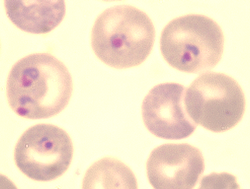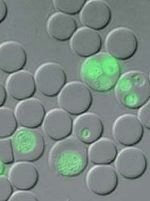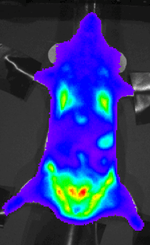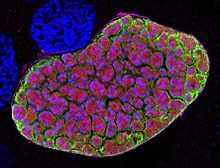Plasmodium berghei
| Plasmodium berghei | |
|---|---|
 | |
| Blood forms in red blood cells | |
| Scientific classification | |
| Domain: | Eukarya |
| Kingdom: | Chromalveolata |
| Superphylum: | Alveolata |
| Phylum: | Apicomplexa |
| Class: | Aconoidasida |
| Subclass: | Haemosporidiasina |
| Order: | Chromatorida |
| Suborder: | Laveraniina |
| Family: | Plasmodiidae |
| Genus: | Plasmodium |
| Species: | P. berghei |
| Binomial name | |
| Plasmodium berghei | |
Plasmodium berghei is a unicellular parasite (protozoan) that infects mammals other than humans.
P. berghei is one of the four Plasmodium species that have been described in African murine rodents, the others being:
These are not of direct practical concern to man or his domestic animals. The interest of these parasites is that they are practical model organisms in the laboratory for the experimental study of human malaria.
Description
This species was first described by Vincke and Lips in 1948 in the Belgian Congo.[1]
Geographical occurrence
P. berghei is found in the forests of Central Africa, where its natural cyclic hosts are the thicket rat (Grammomys surdaster) and the mosquito (Anopheles dureni).
Mammalian hosts
Thicket rat (Grammomys surdaster), Leggada bella, Praomys jacksoni and Thamnomys surdaster
Vectors
- Anopheles dureni
Research

Rodent malaria parasites are used in many research institutes for studies aiming at the development of new drugs or a vaccine against malaria.
In the laboratory the natural hosts have been replaced by a number of commercially available laboratory mouse strains, and the mosquito Anopheles stephensi, which is comparatively easily reared and maintained under defined laboratory conditions. Rodent parasites are recognised as valuable model organisms for the investigation of human malaria because they are similar in most essential aspects of morphology, physiology and life cycle and the manipulation of the complete lifecycle of these parasites, including mosquito infections, is simple and safe.
Like all malaria parasites of mammals, including the four human malaria parasites, P. berghei is transmitted by Anopheles mosquitoes and it infects the liver after being injected into the bloodstream by a bite of an infected female mosquito. After a short period (a few days) of development and multiplication, these parasites leave the liver and invade erythrocytes (red blood cells). The multiplication of the parasite in the blood causes the pathology such as anaemia and damage of essential organs of the host such as lungs, liver, spleen. P. berghei infections may also affect the brain and can be the cause of cerebral complications in laboratory mice. These symptoms are to a certain degree comparable to symptoms of cerebral malaria in patients infected with the human malaria parasite Plasmodium falciparum.[2]
The complete genome of P. berghei has been sequenced[3][4][5] and it shows a high similarity, both in structure and gene content, with the genome of the human malaria parasite Plasmodium falciparum.

P. berghei can be genetically manipulated in the laboratory using standard genetic engineering technologies. Consequently this parasite is often used for the analysis of the function of malaria genes using the technology of genetic modification.[6][7][8]
A number of genetically modified P. berghei lines have been generated which express fluorescent reporter proteins such as Green Fluorescent Protein (GFP) and mCherry (red) or bioluminescent reporters such as Luciferase. These transgenic parasites are important tools to study and visualize the parasites in the living host.[9][10]

P. berghei is used in research programs for development and screening of anti-malarial drugs and for the development of an effective vaccine against malaria.
The use of this model malaria parasite has provided biologists and medical researchers with more insight into:
- The interactions of malaria parasites with the immune system.
- The process of infection of the liver by malaria parasites.
- The cause of pathology induced by malaria infections, such as cerebral complications or lung pathology.
- The infection of the mosquito and transmission of the parasite by the mosquito.
- The function of parasite proteins that have been identified as putative targets for development of a vaccine
- Generation of genetically attenuated parasites (GAP) and their use to induce protective immune responses by vaccination with GAP[11]
References
- ↑ Vincke, I.H. and Lips, M. (1948) Un nouveau plasmodium d'un rongeur sauvage du Congo: Plasmodium berghei n.sp. Annales de la Société Belge de Médecine Tropicale 28, 97-104
- ↑ Franke-Fayard B et al. (2010) Sequestration and tissue accumulation of human malaria parasites: can we learn anything from rodent models of malaria? PLoS Pathogens 6(9):e1001032
- ↑ Hall et al. (2005) A comprehensive survey of the Plasmodium life cycle by genomic, transcriptomic, and proteomic analyses. Science 307, 82-6
- ↑ Kooij TW, Janse CJ, Waters AP. (2006) Plasmodium post-genomics: better the bug you know? Nat Rev Microbiol. 4:344-357
- ↑ Otto TD, et al. (2014) A comprehensive evaluation of rodent malaria parasite genomes and gene expression. BMC Biology 12:86
- ↑ Janse CJ, Ramesar J, Waters AP. High-efficiency transfection and drug selection of genetically transformed blood stages of the rodent malaria parasite Plasmodium berghei. Nature Protocols 2006, 1:346-56.
- ↑ Janse C.J. et al (2011) A genotype and phenotype database of genetically modified malaria-parasites. Trends Parasitol. 27:31-39.
- ↑ Khan SM, Kroeze H, Franke-Fayard B, Janse CJ. (2013) Standardization in generating and reporting genetically modified rodent malaria parasites: the RMgmDB database. Methods Mol Biol. 2013;923:139-50.
- ↑ Amino R, Ménard R, Frischknecht F. In vivo imaging of malaria parasites--recent advances and future directions. Curr Opin Microbiol. 2005 8:407-14
- ↑ Franke-Fayard B, Waters AP, Janse CJ. Real-time in vivo imaging of transgenic bioluminescent blood stages of rodent malaria parasites in mice. Nature Protocols 2006, 1:476-85.
- ↑ Khan SM, Janse CJ, Kappe SH, Mikolajczak SA.(2012) Genetic engineering of attenuated malaria parasites for vaccination. Curr Opin Biotechnol. 23:908-916
External links
| Wikimedia Commons has media related to Plasmodium berghei. |
- General information about (the biology of) P. berghei
- Information about the genome and genes of P. berghei